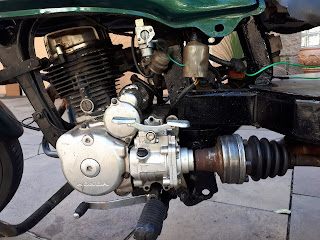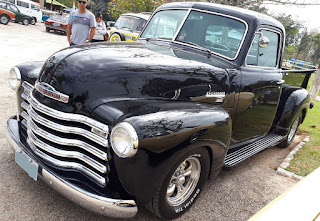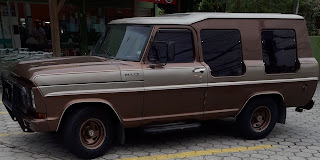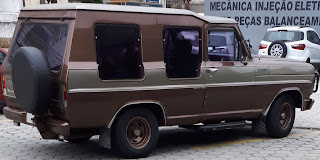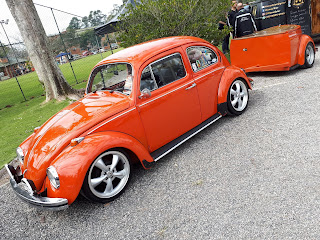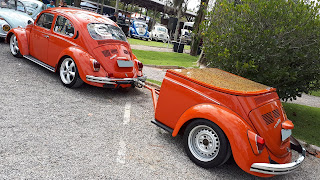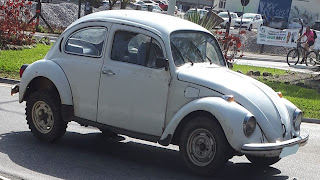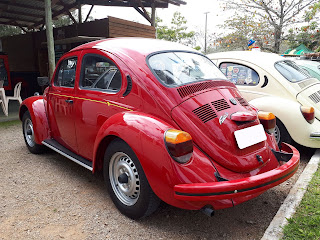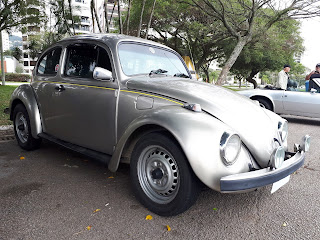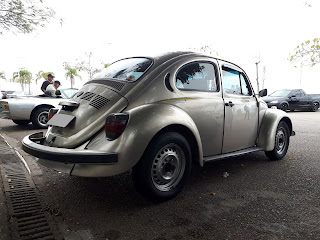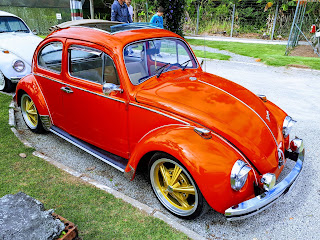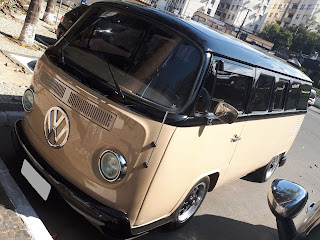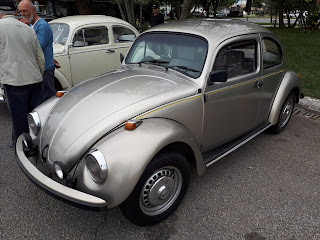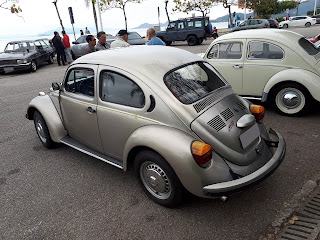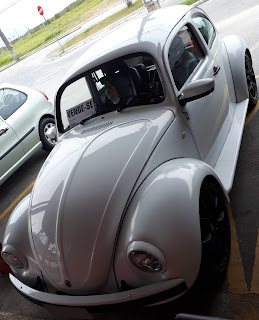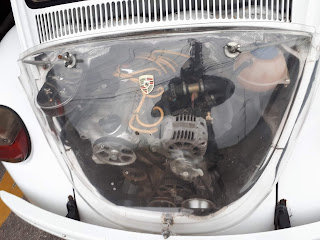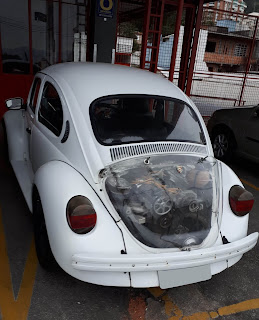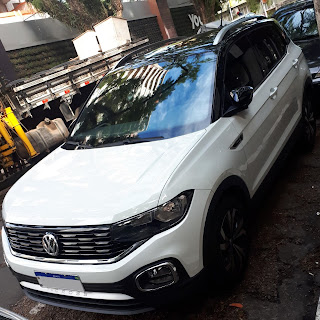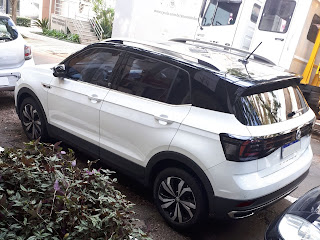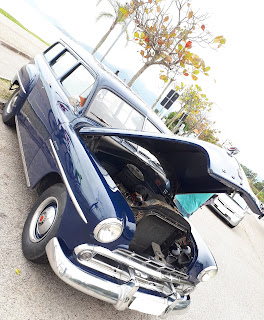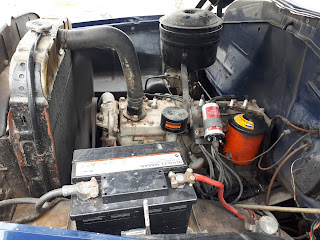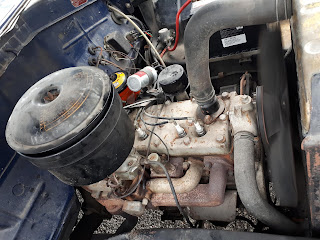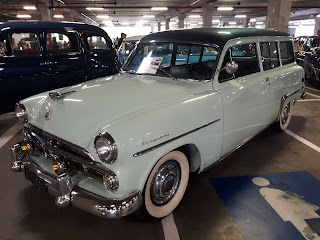I met the owner of this Honda CG 125 tricycle when it still had the stock fuel tank and chain-drive. Besides adapting the tank of the Honda CB 400 from the '80s, in the meantime it had also been converted to shaft-drive.
Enabling the coupling of a driveshaft to the secondary drive is an auxiliary gearbox that not only turns the sense of rotation in a 90-degree angle but also provides reversing. It's a common feature in many Chinese tricycles, but only recently it became more widespread in Brazilian conversions.
Originally converted by a company that is now defunct, it was basically rebuilt by its owner who made an entirely new rear subframe suitable to the fitment of an Asia Motors Towner/Daihatsu HiJet rear axle which also had to be narrowed and having the differential pumpkin relocated closer to the left edge of the axle in order to be properly alligned with the driveshaft.
Final drive ratio is now lower than what was used when it still relied on chain-drive, decreasing the top speed, but for a strictly urban usage on short distances it's still suitable.
Thursday, November 28, 2019
Saturday, November 16, 2019
Chevrolet Advanced Design and its Brazilian restyling
The pick-up box retains more of the original style of the American model, with less curves on the rear fenders being the most noticeable difference.
Wednesday, October 16, 2019
Nissan D21 with a sedan-like conversion
The trend of converting pick-up trucks into some sort of oversized sedan in Brazil, which had its days of glory in Brazil during the '80s as a step ahead of the more utilitarian approach of a simpler double-cab into something more aspirational, didn't fade away completely once imports were resumed in '90. Even though more focused on locally-made models, similar setups were also often applied to imports such as the Nissan D21 Pick-Up. This one, presumably converted by Tropical Cabines, had a similar treatment to what was applied to local full-size Ford and Chevrolet trucks which were the most often converted.
Saturday, October 12, 2019
Argentinian-made Chevrolet D-20 with a Brazilian sedan-like conversion cab
Brazil might be a surprising country when it comes to vehicles, mostly due to the previously closed market which led to the development of local makeshift aftermarket approaches to address the lack of options from the major foreign-based automakers such as Chevrolet. Among such offers were some crew-cab conversions for trucks which ended up turning them into something closer to an oversized sedan. One of the most known companies focused on truck-based coachbuilding is Tropical Cabines, which resorts to fiberglass on its conversions such as this Argentinian-made '95 Chevrolet D-20 which had a 3-door cabin and a sedan-like rear trunk instead of the usual open truck bed.
The fact that some restrictions based either on cargo or passenger capacity are enforced against the usage of Diesel engines in Brazil, originally meant as a deterrent to its application on private vehicles in order to relieve the fuel demand for utilitarian purposes, has rendered such conversions quite popular before the imports restricted in '76 were reopened in '90, even though much of its market-share became extinct with the arrival of more conventional crew-cab trucks and the SUV trend.
The fact that some restrictions based either on cargo or passenger capacity are enforced against the usage of Diesel engines in Brazil, originally meant as a deterrent to its application on private vehicles in order to relieve the fuel demand for utilitarian purposes, has rendered such conversions quite popular before the imports restricted in '76 were reopened in '90, even though much of its market-share became extinct with the arrival of more conventional crew-cab trucks and the SUV trend.
Friday, October 04, 2019
Brazilian '02 Chevrolet Blazer with underbody CNG kit
Natural gas is quite popular in Brazil as a motor fuel, even though its availability is not nationwide. However, one of the most mentioned side-effects besides occasional decreases on the performance is the space usually taken by the tanks when they're mounted inside the luggage compartment. Some vehicle such as the 2nd-generation Chevrolet S10 Blazer, which by the way was the only generation of this model to be made in Brazil, the fitment of the tanks under the floor is an option much sought after because of its lesser impact over the load volume. However, in the Blazer a removal of the rear sway-bar is required in order to get clearance for a pair of CNG tanks and their braces to fit in the space where the stock spare wheel rack is fitted.
Tuesday, September 24, 2019
Brazilian Ford F-1000 from late '80s to early '90s converted into some sort of mix between SUV and van
It may seem odd at a first glance, but the full-size Ford trucks range in Brazil didn't follow the same evolution path of its American/Canadian/Mexican and Argentinian counterparts, with local variants of the 5th generation being introduced only in '72 when it was already being phased out anywhere else, with a subtle facelift which led to the introduction of a plastic grille and 4 square headlamps, and soldiering on until '92 when a switch to the 8th generation was on course. Unique to the local market was the F-1000 which was basically an equivalent to the F-250 with the short-bed bodystyle of the F-100 and a regionally-sourced 3.9L MWM D-229-4 Diesel engine later also available with turbo, or the Thriftpower Six imported from Argentina in a dedicated-ethanol version specific for the Brazilian F-1000 or in a regular gasoline-powered version only in '90.
It used to be quite common to see many aftermarket conversions for full-size trucks in Brazil, which were also somewhat of an attempt to fill the gaps left by the restrictions against car imports between '76 and '90. Among those, there were some bodyworks halfway between an SUV and a full-size van, often leading to such vehicles being mistaken for a Mexican Ford B-100 or similar conversions which also used to be performed in Argentina where they're often referred to as "F-100 carrozada" or "F-100 rural". What might surprise Americans and Canadians the most is the resemblance to the panel vans based on older generations of the F-Series, but the absence of the Econoline vans in other markets by then has led to such conversions having their popularity, even though in Brazil they were more often seen as a recreational vehicle than as a workhorse.
It used to be quite common to see many aftermarket conversions for full-size trucks in Brazil, which were also somewhat of an attempt to fill the gaps left by the restrictions against car imports between '76 and '90. Among those, there were some bodyworks halfway between an SUV and a full-size van, often leading to such vehicles being mistaken for a Mexican Ford B-100 or similar conversions which also used to be performed in Argentina where they're often referred to as "F-100 carrozada" or "F-100 rural". What might surprise Americans and Canadians the most is the resemblance to the panel vans based on older generations of the F-Series, but the absence of the Econoline vans in other markets by then has led to such conversions having their popularity, even though in Brazil they were more often seen as a recreational vehicle than as a workhorse.
Tuesday, September 17, 2019
Beetle with a matching trailer
I'm not really into matching trailers, but this one I spotted at a car show caught my attention. Not sure if it resorted to a chopped Beetle floorpan or a dedicated frame.
Sunday, September 08, 2019
Why would I still consider buying a Beetle?
One of those cars that have created new standards at the time of its introduction, even though some of its features fell out of favor among the general public, the Beetle still retains a strong cult-following in countries such as Brazil where it's often praised for addressing effectively the needs of its buyers. Unlike newer generations of subcompacts which have stripped-down versions advertised as "people's car", and other projects specific for the so-called emerging markets while still catering mostly to the urban customers, its mild off-road ability renders the Beetle suitable to rural and suburban users who either couldn't afford some 4WD utility vehicle or didn't want to deal with the technical complexity associated to that feature. Knobby tyres on the rear end, and eventually some selective rear braking similar to what is used in some farm tractors (and that could be easily implemented using the parking brake cables), are enough for a Beetle to cope with most of the rough terrain conditions...
Sure it's undeniable the Beetle may seem too outdated when compared to other "people's car" projects which were eventually meant to serve as an indirect replacement for it, but the shift in the customers' mindset simply reflects other changes in a broader social and economical context. The relaunch of the Beetle in '93 in Brazil, only to be definitely phased out locally in '96, was clearly more influenced by a wish of then-president Itamar Franco who believed it would boost sales of "people's cars" instead of a technically-biased decision. Its body-on-platform layout rendered it uncompetitive for a large-scale production while compared to newer unibody cars, including the 2nd-generation Gol released in '94 and initially resorting to the Ford-sourced 1.0L CHT engine renamed AE by the Brazilian branch of Volkswagen until '96. Since the "people's car" program rules had to be amended just in order to allow the Beetle with its air-cooled 1.6L engine to take benefit of a lower tax bracket at the time meant for engines up to 1.0L regardless of the cooling system, switching back soon after the Beetle bit the dust again, the "Fusca Itamar" ended up more as a marketing stunt than as a serious attempt to address the needs of customers.
It could seem out of question to even lurk about the possibility of getting a Beetle when something more modern was available for roughly the same price, but it's not that easy to single-out which could be the best vehicle within one or more size classes that could often overlap each other. Considering the specificities of the Brazilian market in the early '90s, still reflecting the reserve for locally-made cars held between '76 and '90, the closest contender to the Beetle regarding strictly its off-road ability was the Suzuki Samurai, predictably disfavored among customers with a more traditional profile who would not be willing to deal with the smaller availability of official technical assistance. And even though the Samurai had been more often imported to Brazil with a 1.3L engine which for being water-cooled didn't benefit from the same amendment on the "people's car" program that favored the Beetle, there were a few imported with a 970cc engine which enabled it to qualify for the lower taxes. Considering that both models were designed according to programs similar to the Brazilian "people's car", even though the Beetle catered to a broader array of customers while the Samurai being a 4WD became somewhat more aspirational as a specialty vehicle, it doesn't make so much sense to compare sales figures.
The lack of any serious evolution between the original production run of the Beetle in Brazil and the Itamar, which didn't even get the upgraded rear suspension with semi-trailing arms and coil springs, is obviously a matter of concern. Stiffer sway bars may already provide some degree of compensation to the side-effects of the stock rear swing-axle, even though it's not impossible to install the improved rear suspension which in Brazil was found on the Transporter/Kombi since '76, which may be enough to keep its handling more up-to-date within normal operating conditions, and even the retrofitting of an ABS system if desired is not out of question despite the projects' age. It's also worth noticing the possibility to implement higher-capacity brakes, which could handle some more spirited driving and eventually address the higher efforts which would be imposed either by some engine tuning or by its swap for a modern one. Comfort features now highly sought after on new vehicles but not so much when the Beetle and the Kombi were mainstream, such as air conditioning and power steering, can be fitted too, with or without other improvements.
Be it for the simple mechanics and the utilitarian approach, or some more subjective reasons such as the iconic appearance, a Beetle may still be considered desirable by customers with distinct profiles. Easy to fix with simple tools, capable to withstand to some degree of maintenance neglect, and lower-grade fuel and other supplies such as engine oils, even the controversial relaunch could be considered a sign that a vehicle with at least some of the Beetle's features was effectively needed in Brazil back in the day. Not so fancy as neither other classic cars or most of its modern indirect replacements, the Beetle might be far from being a strictly-reasonable buy but is not unjustifiable at all...
Sure it's undeniable the Beetle may seem too outdated when compared to other "people's car" projects which were eventually meant to serve as an indirect replacement for it, but the shift in the customers' mindset simply reflects other changes in a broader social and economical context. The relaunch of the Beetle in '93 in Brazil, only to be definitely phased out locally in '96, was clearly more influenced by a wish of then-president Itamar Franco who believed it would boost sales of "people's cars" instead of a technically-biased decision. Its body-on-platform layout rendered it uncompetitive for a large-scale production while compared to newer unibody cars, including the 2nd-generation Gol released in '94 and initially resorting to the Ford-sourced 1.0L CHT engine renamed AE by the Brazilian branch of Volkswagen until '96. Since the "people's car" program rules had to be amended just in order to allow the Beetle with its air-cooled 1.6L engine to take benefit of a lower tax bracket at the time meant for engines up to 1.0L regardless of the cooling system, switching back soon after the Beetle bit the dust again, the "Fusca Itamar" ended up more as a marketing stunt than as a serious attempt to address the needs of customers.
It could seem out of question to even lurk about the possibility of getting a Beetle when something more modern was available for roughly the same price, but it's not that easy to single-out which could be the best vehicle within one or more size classes that could often overlap each other. Considering the specificities of the Brazilian market in the early '90s, still reflecting the reserve for locally-made cars held between '76 and '90, the closest contender to the Beetle regarding strictly its off-road ability was the Suzuki Samurai, predictably disfavored among customers with a more traditional profile who would not be willing to deal with the smaller availability of official technical assistance. And even though the Samurai had been more often imported to Brazil with a 1.3L engine which for being water-cooled didn't benefit from the same amendment on the "people's car" program that favored the Beetle, there were a few imported with a 970cc engine which enabled it to qualify for the lower taxes. Considering that both models were designed according to programs similar to the Brazilian "people's car", even though the Beetle catered to a broader array of customers while the Samurai being a 4WD became somewhat more aspirational as a specialty vehicle, it doesn't make so much sense to compare sales figures.
The lack of any serious evolution between the original production run of the Beetle in Brazil and the Itamar, which didn't even get the upgraded rear suspension with semi-trailing arms and coil springs, is obviously a matter of concern. Stiffer sway bars may already provide some degree of compensation to the side-effects of the stock rear swing-axle, even though it's not impossible to install the improved rear suspension which in Brazil was found on the Transporter/Kombi since '76, which may be enough to keep its handling more up-to-date within normal operating conditions, and even the retrofitting of an ABS system if desired is not out of question despite the projects' age. It's also worth noticing the possibility to implement higher-capacity brakes, which could handle some more spirited driving and eventually address the higher efforts which would be imposed either by some engine tuning or by its swap for a modern one. Comfort features now highly sought after on new vehicles but not so much when the Beetle and the Kombi were mainstream, such as air conditioning and power steering, can be fitted too, with or without other improvements.
Friday, September 06, 2019
EA827-swapped Beetle with a clear plexiglass engine lid
Seeing a Beetle which had its stock air-cooled boxer engine replaced with something more modern, usually a Volkswagen EA827, is not so unusual at all in Brazil, even though it's a quite controversial mod among local Beetle enthusiasts.
This one specifically, a '94-'95 "Itamar series", had a clear plexiglass engine lid that makes it quite obvious the stock boxer is gone while the EA827 made its way inside...
This one specifically, a '94-'95 "Itamar series", had a clear plexiglass engine lid that makes it quite obvious the stock boxer is gone while the EA827 made its way inside...
Sunday, August 18, 2019
Solar-powered bus
This electric urban shuttle bus was made in Brazil, with a Mercedes-Benz O-500M chassis converted to electric by Eletra, a company specialized in electric drivetrains for heavy commercial vehicles that used to be mostly known for its serial hybrids but now supplies more full-electric systems catering to the trolleybuses of São Paulo city. This one specifically resorts to solar charging for its batteries bank, and is undergoing tests at the Santa Catarina State Federal University (UFSC - Universidade Federal de Santa Catarina) operating regular routes between its main campus and the Sapiens Parque, both in the Florianópolis island.
The body is a Marcopolo Torino Low-Entry, very similar to some Diesel-powered ones that operate regularly in my hometown Porto Alegre, while the overwhelming majority of the urban bus fleet in Florianópolis is front-engined with raised floor. Some differences between this one and a normal bus are mostly noticeable on the roof-mounted battery trays and solar panels, while the cockpit has a few different buttons, a rotary dial instead of the shift buttons for a normal automatic transmission, and the absence of a tachometer.
The electric motor is made by Weg, a company that is headquartered in Jaraguá do Sul, Santa Catarina state, but the electronic controls are developed in-house by Eletra, while the batteries are imported. The chemistry of batteries have been a complex matter, not just due to the improvements on the energy density required for mobile applications such as a vehicle but also because of factors such as the environmental impact of its end-of-life handling nowadays frequently referred to as "reverse logistics". Lithium batteries are not as easy to recycle as Lead-Acid ones which are still more common powering the accessories and the electronic controls in a more conventional vehicle with an internal-combustion engine.
One thing I can't deny, this bus got me thinking about some previous opportunities to develop local technologies for electric vehicles, including batteries with a higher efficiency back in the day when it was either Lead-Acid or those highly toxic Nickel-Cadmium ones. It's impossible to neglect the efforts of João Augusto Conrado do Amaral Gurgel, the same developer of a local attempt to replace the Beetle in the '80s, who also researched on batteries for EVs which he considered more promising than the ethanol despite his good relationship with the '64-'85 military government more supportive to ethanol. I'm sure it would be interesting to say the least if Gurgel's tetrapolar batteries get replicated with modern battery chemistry in order to improve its energy density...
The body is a Marcopolo Torino Low-Entry, very similar to some Diesel-powered ones that operate regularly in my hometown Porto Alegre, while the overwhelming majority of the urban bus fleet in Florianópolis is front-engined with raised floor. Some differences between this one and a normal bus are mostly noticeable on the roof-mounted battery trays and solar panels, while the cockpit has a few different buttons, a rotary dial instead of the shift buttons for a normal automatic transmission, and the absence of a tachometer.
The electric motor is made by Weg, a company that is headquartered in Jaraguá do Sul, Santa Catarina state, but the electronic controls are developed in-house by Eletra, while the batteries are imported. The chemistry of batteries have been a complex matter, not just due to the improvements on the energy density required for mobile applications such as a vehicle but also because of factors such as the environmental impact of its end-of-life handling nowadays frequently referred to as "reverse logistics". Lithium batteries are not as easy to recycle as Lead-Acid ones which are still more common powering the accessories and the electronic controls in a more conventional vehicle with an internal-combustion engine.
One thing I can't deny, this bus got me thinking about some previous opportunities to develop local technologies for electric vehicles, including batteries with a higher efficiency back in the day when it was either Lead-Acid or those highly toxic Nickel-Cadmium ones. It's impossible to neglect the efforts of João Augusto Conrado do Amaral Gurgel, the same developer of a local attempt to replace the Beetle in the '80s, who also researched on batteries for EVs which he considered more promising than the ethanol despite his good relationship with the '64-'85 military government more supportive to ethanol. I'm sure it would be interesting to say the least if Gurgel's tetrapolar batteries get replicated with modern battery chemistry in order to improve its energy density...
Thursday, August 15, 2019
Brazilian Volkswagen T-Cross: surprisingly the cheaper engine not available on the local market
Recently introduced in Brazil, the Volkswagen T-Cross had been available only with turbocharged engines also fitted with direct injection, either the 3-cylinder 1.0L or the 4-cylinder 1.4L of the TSI range. However, for some regional export markets such as Argentina and Uruguay, the 1.6L MSI still naturally aspirated and with port injection is the only one available. There were times when Brazilian versions of certain models had the simpler engines, while the ones available in neighboring countries were more sophisticated, so it's somewhat surprising to see it going the other way around. Possibly the fact that both Uruguay and Argentina don't have such a strict displacement-tiered vehicle taxation structure as the one enforced in Brazil, most of the Europe and China renders an older engine with a greater displacement more competitive than the 1.0TSI for the entry-level versions, even though at least the 1.4TSI could eventually make its way on to the export markets for the Highline trim. At least in Argentina, it's also worth to notice the popularity of CNG aftermarket conversions, for which the port-injected 1.6L MSI is easier to implement than the TSI range, even though both the 1.0L and 1.4L TSI engines are available in a TGI trim optimized for CNG while retaining the ability to use gasoline on limp-home mode.
Another aspect to consider is the eventual altitude compensation provided by a turbocharger, even though the turbo-lag becomes somewhat more noticeable further above the mean sea level. Uruguay is comprised mostly of flat lands, so this effect is mostly negligible, while Argentina also features some stretches of hilly terrain on its part of the Andean Mountains. Among other regional export markets, Paraguay and Mexico are also relevant to consider when it comes to the difference between some eventual suitability of different engine layouts on each market. Versions available officially in Paraguay are fitted with the very same TSI engines used in Brazil, including the ethanol-capable "flexfuel" trim, while in Mexico there is some rumor about which engines will be offered, and some sources mention the 1.6L MSI to be more likely to become available there and eventually supplemented with the 1.4L TSI to become available for the higher trims. But in the end, considering the differences between the tax structure in Brazil and export markets, the seemingly outdated yet cheaper 1.6L engine is still clearly favored over smallest TSI on regional export markets where the T-Cross is sourced from Brazil in order to benefit from the Mercosur and other trade agreements.
Another aspect to consider is the eventual altitude compensation provided by a turbocharger, even though the turbo-lag becomes somewhat more noticeable further above the mean sea level. Uruguay is comprised mostly of flat lands, so this effect is mostly negligible, while Argentina also features some stretches of hilly terrain on its part of the Andean Mountains. Among other regional export markets, Paraguay and Mexico are also relevant to consider when it comes to the difference between some eventual suitability of different engine layouts on each market. Versions available officially in Paraguay are fitted with the very same TSI engines used in Brazil, including the ethanol-capable "flexfuel" trim, while in Mexico there is some rumor about which engines will be offered, and some sources mention the 1.6L MSI to be more likely to become available there and eventually supplemented with the 1.4L TSI to become available for the higher trims. But in the end, considering the differences between the tax structure in Brazil and export markets, the seemingly outdated yet cheaper 1.6L engine is still clearly favored over smallest TSI on regional export markets where the T-Cross is sourced from Brazil in order to benefit from the Mercosur and other trade agreements.
Wednesday, August 14, 2019
4 reasons why sidevalve/"flathead" engines could make a comeback
1 - ease of servicing: with fewer parts, and some critical componets easier to reach whenever some technical intervention becomes required, it also saves time and thus enables the vehicle to resume its usual operating routine sooner. Even a full engine overhaul, if it ever becomes required during the useful operating life of a vehicle fitted with a sidevalve engine, takes less time and fewer raw materials are needed because of the lower amount of parts in need of a replacement;
2 - lower revving: leading to advantages such as a longer engine longevity, besides being optimized for low-end torque which enables keeping a comfortable cruising speed on a higher gear with fewer RPMs, the peak torque closer to idle may also render it easier for novice drivers to learn how to use a manual transmission (which nowadays with so many automatics might serve as somewhat of a passive anti-theft device). Obviously can't compare so accurately to a more rev-happy modern engine, but the greater lower-end torque renders a larger-displacement sidevalve operating at lower RPMs paired to a higher gear ratio suitable to perform the same tasks with fewer stress;
3 - low manufacturing cost: with fewer parts due to its simpler designs, and some such as the cylinder head being noticeably simpler than what would be found on any other 4-stroke engine, a sidevalve could appeal to some conservative and budget-conscious buyer. For work vehicles such as trucks, which are also usually not so burdened by a displacement-biased tax structure which is prevalent in Europe and South America, this advantage may remain easier to exploit;
4 - possibly beneficial side-effects of a lower compression ratio: in a time when most spark-ignited engines now feature direct injection in order to enable a sky-high compression ratio and lean-burn leading to a more Diesel-ish fuel efficiency, the more conservative compression ratio on a sidevalve may not be so bad at all. As it leads to a lower aerodynamic heating of the intake charge, a leaner air/fuel ratio won't increase any likelyhood to pre-ignition/knocks, all while it also avoids the increase on Nitrogen oxides (NOx) which now plagues most direct-injection gasoline-powered or "flexfuel" engines able to operate on ethanol. So, even with a more affordable and easier to service conventional port-injection system replacing the carburettors which prevailed on the sidevalves' days of glory, some competitive fuel efficiency may not be out of question. And if some alternate fuel such as CNG is used, which is not the case on the collector vehicles I usually see that still feature their original drivetrain such as this '53 Dodge Kingsway, it's roughly impossible to trim the mixture so low to still enable combustion amidst an increased risk of overheating usually associated to an excessively lean air/fuel ratio;
Subscribe to:
Comments (Atom)

